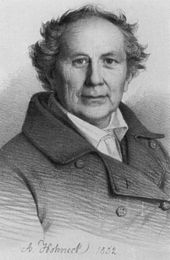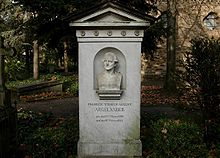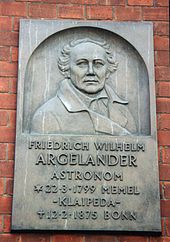Friedrich Wilhelm August Argelander
Friedrich Wilhelm August Argelander (born March 22, 1799 in Memel , † February 17, 1875 in Bonn ) was a German astronomer . He led the construction of several observatories in Europe , examined variable stars and carried out the Bonn survey , the 325,000 stars of which he summarized in a star catalog .
biography
Training in East Prussia
Argelander was born in Memel in East Prussia . His father, the wholesale merchant and shipowner Johann Gottlieb Argelander, was of Finnish descent and his mother, Wilhelmina Dorothea Grünhagen, of German descent. After the lost battle of Jena and Auerstedt (1806), the Prussian royal family left Berlin and stayed temporarily in Memel. The Crown Prince, later King Friedrich Wilhelm IV. , Therefore visited Argelander's parents' house several times and made friends with his son.
Argelander attended grammar school in Elbing and from 1813 the Collegium Fridericianum in Königsberg . In 1817 he began studying at the University of Königsberg . Here he was fascinated by the astronomical lectures given by Friedrich Wilhelm Bessel , director of the Königsberg observatory . Argelander became Bessel's assistant in 1820 and supported him in the exact determination of star positions, so-called star words . In 1822 he received his doctorate with a critical examination of the observations of John Flamsteed . In the same year he published the book "Investigations into the orbit of the Great Comet of 1811", which made him known in specialist circles all over Europe.
Activity in Finland
In 1823 a position as an observer at the observatory in Turku, Finland, became vacant. Bessel should suggest one of his former students for this. Reluctantly, he proposed to Argelander, as he was reluctant to lose his best colleague, and wrote a corresponding letter of recommendation to those responsible in Saint Petersburg . The trip to Finland was also Argelander's honeymoon; on May 2, 1823 he had married Marie Sophie Charlotte Courtan. The Turku observatory had only recently been completed and was not yet fully set up. At that time she had a telescope designed by Joseph von Fraunhofer with an opening width of 20 cm , which was used as a pass-through instrument, and a heliometer . In the early years, the observatory's main activity was the observation of comets . After a meridian circle was available in 1827 , Argelander examined stars with high intrinsic motion .
On September 4, 1827, a major fire destroyed large parts of Turku, including the university buildings. The university was then moved to what was then Helsingfors (today: Helsinki). Although the observatory was only slightly affected by the fire due to its isolated location, the institute was also relocated. In 1828 Argelander was appointed professor at the newly established University of Helsingfors . The plans for a new observatory were available in 1830. Due to the unfavorable soil conditions, difficulties arose in creating the foundation and the project was delayed. Argelander used the time, traveled to East Prussia and recruited new employees from the ranks of Bessel's students. During this time he also created a sheet for the star map series of the Royal Prussian Academy of Sciences in Berlin. From 1833 onwards, the observatory was able to commence its operations to a limited extent. Argelander carried out exact determinations of the bright circumpolar stars and determined the proper motion of the solar system from the motion of 390 stars .
Appointment to Bonn
In 1836 the Prussian government decided to set up an astronomical institute at the University of Bonn . The position of director of the observatory was offered to Argelander, which he accepted (his predecessor was Karl Dietrich von Münchow ). In 1837 he moved to Bonn and prepared to build an observatory. During this time he used an old fortress on the Rhine for his observations. He determined the apparent brightness of all stars visible to the naked eye from Central Europe. He dealt extensively with variable stars and later developed the so-called Argelander step estimation method . In the years that followed and before the development of photography and electronic measuring devices, it proved to be an indispensable aid for observing variable stars and for photometry . Since the construction of the observatory progressed only slowly, Argelander built a small observatory near the Rhine fortress in which he set up a Fraunhofer comet finder with a 7.7 cm aperture (three Prussian inches) and 65 cm focal length. From 1841 to 1843, with the help of an assistant, he determined the position of about 22,000 stars.
The new Bonn observatory on Poppelsdorfer Allee (which became a university institute on January 1, 2006 in the Argelander Institute for Astronomy ) was completed in mid-1844 and inaugurated in 1845. A number of comets and asteroids were observed over the next few years . In 1847 he recognized the highest proper motion of a star at Groombridge in 1830 . In 1849 Argelander began a new survey of the sky. He divided the sky into 200 zones and carried out 23,250 observations on 17,000 stars by May 1852. Every position and brightness determination was compared with known stars in order to achieve the highest possible degree of accuracy.
In 1850/51 and 1864/65 he was the rector of the university.
Bonn survey
The survey was not finished when Argelander embarked on an even bigger project. At the time, Bessel had proposed the determination of all stars up to the 9th magnitude , but did not carry it out. Argelander decided to carry out the "large survey", whereby all stars up to the 9th magnitude of the northern hemisphere should be recorded up to a declination of 2 °. By 1863, Argelander and his assistants Adalbert Krüger and Eduard Schönfeld measured 324,198 stars and made maps. The only aid in creating this work was a telescope with an aperture of 78 mm, a focal length of 630 mm and a magnification of nine times. The resulting star catalog is called the Bonn survey (the telescope from the Fraunhofer workshop is still in Bonn and can be viewed).
In 1863 Argelander was one of the founders of the German Astronomical Society and from 1864-67 chairman.
Argelander pointed out the need to determine the star positions shown in the Bonn survey more precisely. However, this task would have to be shared by several observatories. A corresponding proposal was accepted by the Astronomical Society in 1867. The Bonn observatory was assigned a 10 ° wide zone. Argelander himself no longer took part in the observations, but carried out measurements of the star's own movements.
Argelander was in excellent health until 1874. In the summer, however, he fell ill with a typhoid fever that was rampant in the area. In autumn there was initially an improvement, but his strength waned in the following period and he died on February 17, 1875.
family
He was married to Marie Sophie Charlotte Courtan (1801-1883) from Königsberg since May 2, 1823. The couple had several children including:
- Heinrich Lorentz (1834–1908)
- Maria Wilhelmine Amalie (1827–1917) ⚭ Adalbert Krüger (1832–1896), director of the Helsinki observatory
- Maria Olga Elisabeth (1836-1854)
- Anna Mathilde Auguste (1838–1872) ⚭ 1865 Julius Theodor Wolff (1827–1899), astronomer in Bonn and Munich
Honors
In 1846 he was elected a corresponding member of the Göttingen Academy of Sciences . In 1851 he was elected to the Académie des Sciences and in 1855 to the American Academy of Arts and Sciences , in 1864 to the National Academy of Sciences . In 1871 he became a corresponding member of the Bavarian Academy of Sciences .
In 1837 he was awarded the Demidow Prize and in 1863 the gold medal of the Royal Astronomical Society . He was a member of the Pour le Mérite order for sciences and arts.
A large plaque commemorates Argelander at the house where he was born in Memel. The Argelander Institute for Astronomy in Bonn is named after him. There is an Argelanderstraße in Bonn and Oberkochen .
The lunar crater Argelander and the asteroid (1551) Argelander also bear his name .
Works
- Observationes astronomicae in specula universitatis Fennicae factae . 3 volumes Helsinki (Helsingfors) 1830–1832.
- DLX stellarum fixarum positiones mediae ineunte anno 1830 . Helsinki 1835.
- About the solar system's own movement . Saint Petersburg 1837
- Survey of the northern sky between 45 ° and 80 ° north declination . Bonn 1848.
- New uranometry . Berlin 1843.
- Survey of the sky zone between 15 ° and 31 ° south declination. In: Astronomical observations at the Bonn observatory. 1846-1852
- Atlas of the northern starry sky . Bonn 1857–1863: 40 maps
literature
- Siegmund Günther : Argelander, Friedrich . In: Allgemeine Deutsche Biographie (ADB). Volume 46, Duncker & Humblot, Leipzig 1902, pp. 36-38.
- Zinner, Ernst: Argelander, Friedrich Wilhelm August. In: New German Biography (NDB). Volume 1, Duncker & Humblot, Berlin 1953, ISBN 3-428-00182-6 , p. 350 ( digitized version ).
- Manfred Klischies: Argelander - The Astronomer. Verlag M. Simmering , Lilienthal 1999, ISBN 3-927723-42-8 .
- Josef Niesen : Bonn Personal Lexicon. 3rd, improved and enlarged edition. Bouvier, Bonn 2011, ISBN 978-3-416-03352-7 .
- Ralph Burmester, Andrea Niehaus (Hrsg.): Bonn surveys - Argelander and his astronomical legacy. Bonn 2009. Accompanying publication to the special exhibition of the same name in the Deutsches Museum Bonn from October 8, 2009 to April 5, 2010.
- H. Schmidt: Astronomers of the Rheinische Friedrich-Wilhelms-Universität Bonn - their life and work 1819-1966 , Bouvier Verlag, Bonn (1990). ISBN 3416806042 .
Web links
- Brief description with further links
- Friedrich Wilhelm August Argelander's estate in the ULB Bonn
- Argelander and the Bonn survey (Michael Geffert, University of Bonn)
- Argelander in Rhenish History
- Literature by and about Friedrich Wilhelm August Argelander in the catalog of the German National Library
- FWA Argelander publications in the Astrophysics Data System
- NN: Argelander. Astronomical register, vol. 13 (1875), pp. 81-83. (Obituary, English)
- WTL: Friedrich Wilhelm August Argelander. In: Monthly Notices of the Royal Astronomical Society. Vol. 36 (1876), p. 151 (obituary, English)
- A. Krüger: Memorial Address in Honor of Freidrich Wilhelm August Argelander. In: Sidereal Messenger. vol. 2 (1883), pp. 197-204. , Pp. 229-237. , Pp. 276-277. (Biographical Notes, English)
Individual evidence
- ^ Jürgen Hamel : Bessel's project of the Berlin academic star maps. In: The Stars. Volume 65 (1989), pp. 11-19, here: p. 15.
- ↑ Holger Krahnke: The members of the Academy of Sciences in Göttingen 1751-2001 (= Treatises of the Academy of Sciences in Göttingen, Philological-Historical Class. Volume 3, Vol. 246 = Treatises of the Academy of Sciences in Göttingen, Mathematical-Physical Class. Episode 3, vol. 50). Vandenhoeck & Ruprecht, Göttingen 2001, ISBN 3-525-82516-1 , p. 27.
- ↑ member entry by Friedrich Argelander at the Bavarian Academy of Sciences , accessed on 16 December 2016th
- ^ Argelanderstrasse in Germany
- ^ Argelanderstraße in the Bonn street cadastre
| personal data | |
|---|---|
| SURNAME | Argelander, Friedrich Wilhelm August |
| BRIEF DESCRIPTION | German astronomer |
| DATE OF BIRTH | March 22, 1799 |
| PLACE OF BIRTH | near Memel |
| DATE OF DEATH | February 17, 1875 |
| Place of death | Bonn |




